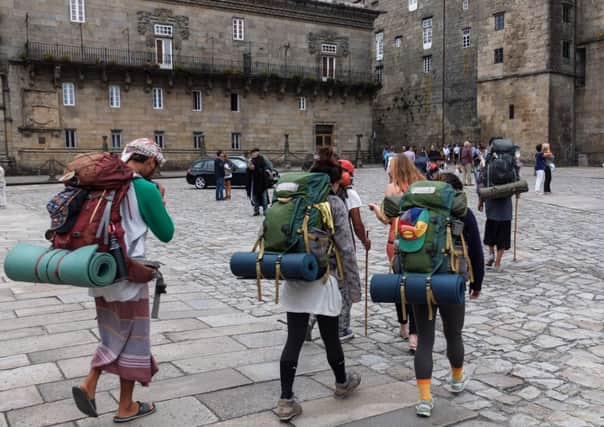Spain: Pilgrim’s progress


The emotion of it all was too much as tears streamed down their cheeks. Two young women, rucksacks and walking sticks discarded, hugging each other for all it was worth, had finished the pilgrim’s route Camino de Santiago and were standing outside the city’s cathedral, journey’s end.
Santiago de Compostela, in Spain, has been a site of pilgrimage for centuries since claims of the discovery of the remains of St James were made. It would appear that it doesn’t matter if you haven’t walked or cycled one of the many routes of the Camino de Santiago (The Way of St James to the English), all are welcome and have been since the Middle Ages.
Advertisement
Hide AdAdvertisement
Hide AdThe back streets, stunning plazas and alleyways of this randomly laid out city have history and the visitor feels part of that evolving story. Santiago de Compostela was the focal point of our trip, one powered by internal combustion engine and not by human power. That would have taken too long for our week in Spain that started well after a smooth crossing from Portsmouth.
Night was closing in as we reached Oviedo for our first night and after a quick check in at our city centre hotel it was time for a meal and a couple of drinks. Cider is enjoyed in this part of the world and it is poured with a flourish. The waiter stretches his pouring arm above his head and tips out the drink from a bottle into a glass held by his other hand near his knee.
We carried on heading west through small towns, stopping for coffee and often doubling the clientele in quiet bars but still receiving a pleasant smile and good service. Eventually Santiago de Compostela appeared on the vehicle’s GPS and the complications began. Imagine York on a really busy day, looking for a hotel buried in the heart of the old city. Our Good Samaritan appeared in the shape of an office worker who stopped to offer help and in his broken English and our more broken Spanish we worked out a way to a car park near the hotel. We must have looked hesitant as he walked off. In a couple of minutes he was back, on his scooter, to lead the way.
As daylight fades the city livens up. The sore legs and blisters are forgotten and pilgrims mingle with tourists in restaurants and bars. Conversations are heard in all languages as visitors prop up local bars, beneath giant hams suspended from the ceiling.
Advertisement
Hide AdAdvertisement
Hide AdThe cathedral, where pilgrims go to thank St. James for their safe journey, is undergoing repairs but the scaffolding and plastic lining cannot diminish its glory. Despite the noise and throng outside the cathedral was cool and quiet. The cloisters, draped in early morning sunlight, and the museum charge an entrance fee and hold some marvellous tapestries and a giant thurible swung by a team of eight men at festivals, producing clouds of incense.
The focal point is the high altar, under which is the crypt with the remains of the Apostle. The architecture is stunning and best enjoyed first thing in the morning before the crowds arrive.
It was easier to leave Santiago de Compostela than to arrive, even without the aid of our scooter-riding guide. We headed back to the east and to the mountains of the Pecos de Europa. Rising from the northwestern coastline of Spain in a majestic fashion, often topped in a shroud of mist, they stand guard to the interior. Deep valleys with sweeping roads lead to passes and jewels of towns. It’s hard to drive these roads without craning up to see the next view.
Inside the Pecos de Europa national park is Covadonga with a late 19th century basilica and cave dedicated to the Virgin of the Battlefield. It was at Covadonga that the Christian reconquest started in the eighth century. The nearby major town of Canga de Onis is a centre for tourism in the area and can get very busy at weekends.
Advertisement
Hide AdAdvertisement
Hide AdSweeping down to the coast, tripping over small coves with sandy beaches, we arrived for our last night at the resort town of Llanes to coincide with a religious festival. It was a damp Sunday but thousands of people crammed into the main street to witness the procession of Our Lady of the Virgin’s Guide.
The month-long celebration takes place all over town but the main event went straight past us. Sacred lanterns, born on wooden litters carried by young men were at the head of the procession followed by ladies and girls dressed in the traditional mantilla head dress in front of the focal point, Our Lady of the Virgin’s Guide. As the statue passed shops and restaurants dimmed their lights. Speeches were made and lost friends remembered. A firework display marked the end and the dancing began. It was a family affair as children clung onto their parents as they made their way to restaurants for a celebration feast.
This rural part of the country contrasts with the usual Spanish tourist destinations and has much to offer. Beautiful beaches and historical sites are all available, and, if you can read a city centre map, you won’t even need a Good Samaritan to enjoy it all.
• Mike Cowling travelled with Brittany Ferries (0871 244 1400, www.brittanyferries.co.uk). They sail year round, up to six times a week from Portsmouth and Plymouth to northern Spain. Prices start from £274 each way for a car plus two people – including en suite cabin. Or for even lower prices, there is a new no-frills economy service from Portsmouth to Santander.
Brittany Ferries can also arrange hotel and holiday accommodation in Spain, with a wide choice of hotels, Paradors, cottages and campsites. (0871 244 1444, www.brittanyferries.com/holidays).